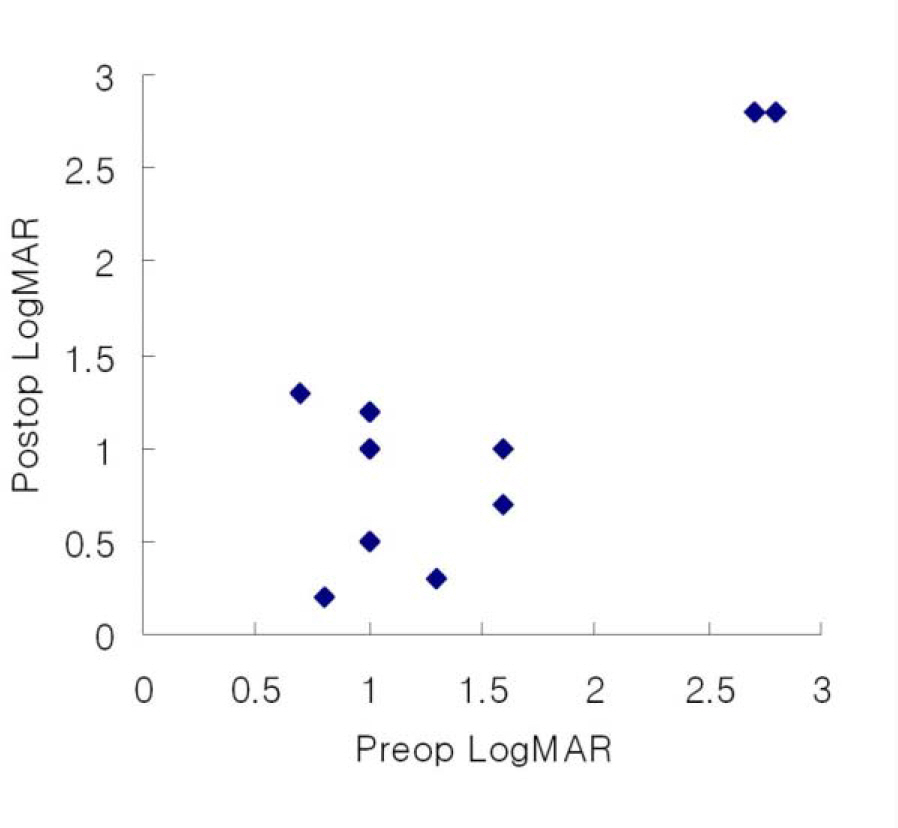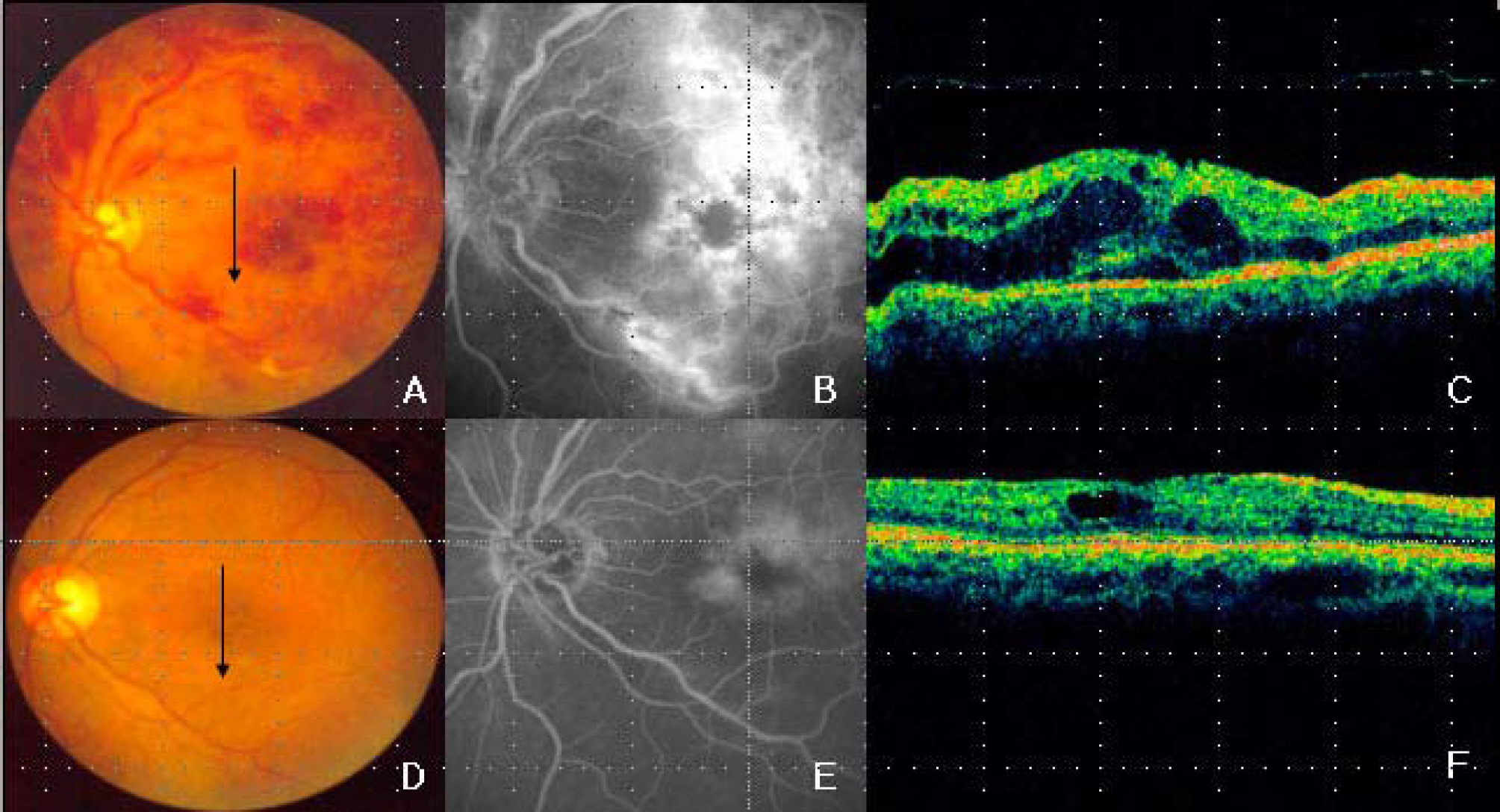J Korean Ophthalmol Soc.
2008 Jan;49(1):111-118. 10.3341/jkos.2008.49.1.111.
The Effect of Internal Limiting Membrane Peeling on Retinal Vein Occlusion Induced Macular Edema
- Affiliations
-
- 1Department of Ophthalmology, Kyungpook National University College of Medicine, Daegu, Korea. itkim@knu.ac.kr
- KMID: 2211190
- DOI: http://doi.org/10.3341/jkos.2008.49.1.111
Abstract
-
PURPOSE: To evaluate the effect of pars plana vitrectomy with indocyanine green-assisted peeling of the internal limiting membrane (ILM) on visual acuity in macular edema in RVO patients.
METHODS
Twenty-three eyes of 23 patients were treated consecutively (male: female=7:16). Thirteen patients were BRVO, and ten patients were CRVO. Vitrectomy that involved peeling the ILM with the assistance of indocyanine dye was performed in all 23 eyes. A visual acuity change of 2 lines or more was regarded as significant. We compared preoperative BCVA and postoperative BCVA.
RESULTS
Improvement of visual acuity was observed in 13 eyes (8 eyes in BRVO, 5 eyes in CRVO) of 23 total eyes (56.5%). No change in visual acuity was observed in 5 eyes (3 eyes in BRVO, 2 eyes in CRVO). Worsening of visual acuity was observed in 5 eyes (2 eyes in BRVO, 3 eyes in CRVO).
CONCLUSIONS
Pars plana vitrectomy with ILM peeling in patients with macular edema induced by RVO showed visual improvement in 56.5% of the cases in our study (61.5% in BRVO, 50% in CRVO). PPV with ILM peeling may be an effective procedure in reducing macular edema due to RVO.
MeSH Terms
Figure
Reference
-
References
1. Mandelcorn MS, Nrusimhadevara RK. Internal limiting membrane peeling for decompression of macular edema in retinal vein occlusion: A report of 14 cases. Retina. 2004; 24:348–55.
Article2. Radetzky S, Walter P, Fauser S, et al. Visual outcome of patients with macular edema after pars plana vitrectomy and indocyanine green-assisted peeling of the internal limiting membrane. Graefes Arch Clin Exp Ophthalmol. 2004; 242:273–8.
Article3. Eye Disease Case Control Study Group. Risk factors for branch retinal vein occlusion. Am J Ophthalmol. 1993; 116:286–96.4. Molnar I, Poitry S, Tsacopoulos M, et al. Effect of laser photocoagulation on oxygenation of the retina in miniature pigs. Invest Ophthalmol Vis Sci. 1985; 26:1410–4.5. Stefansson E, Machemer R, de Juan E Jr, et al. Retinal oxygenation and laser treatment in patients with diabetic retinopathy. Am J Ophthalmol. 1992; 113:36–8.6. The Central Vein Occlusion Study Group M report. Evaluation of grid pattern photocoagulation for macular edema in central vein occlusion. Ophthalmology. 1995; 102:1424–33.7. The Central Vein Occlusion Study Group. Natural History and Clinical Management of Central Retinal Vein Occlusion. Arch Ophthalmol. 1997; 115:486–91.8. Opremcak EM, Bruce RA, Lomeo MD, et al. Radial optic neurotomy for central retinal vein occlusion. A retrospective pilot study of 11 consecutive cases. Retina. 2001; 21:408–15.9. McAllister IL, Douglas JP, Constable IJ, Yu DY. Laser induced chorioretinal anastomosis for non ischemic central retinal vein occlusion: evaluation of the complications and their risk factor. Am J Ophthalmol. 1998; 126:219–29.10. Singh Hayreh S, Opremcak EM, Bruce RA, et al. Radial optic neurotomy for central retinal vein occlusion. Retina. 2002; 22:374–7.
Article11. Samuel MA, Desai UR, Gandolfo CB. Peripapillary retinal detachment after optic neurotomy for central vein occlusion. Retina. 2003; 23:580–3.12. Bresnick GH. Diabetic maculopathy: A critical review highlighting diffuse macular edema. Am J Ophthalmol. 1983; 1301–17.13. Porda SM, Krupin T, Asseff C, Beeker B. Topically administered steroid preparation. Arch Ophthalmol. 1971; 86:251.14. Opatowsky I, Feldman RM, Gross R, Feldman ST. Intraocular pressure elevation associated with inhalation and nasal corticosteroids. Ophthalmology. 1992; 102:177–9.
Article15. Lee J, Lee JH. The effect of intravitreal triamcinolone acetonide on cystoid macular edema. J Korean Ophthalmol Soc. 2004; 45:408–13.16. Kim IC, Ahn M, Cho NC. Intravitreal injection of triamcinolone acetonide for refractory diabetic macular edema. J Korean Ophthalmol Soc. 2004; 45:220–8.17. Sebag J, Balazs EA. Pathogenesis of cystoid macular edema: an anatomic consideration of vitreoretinal adhesion. Surv Ophthalmol. 1984; 28:S493–8.18. Avunduk AM, Centinkaya K, Kapicioglu Z, Kaya C. The effect of posterior vitreous detachment on the prognosis of branch retinal vein occlusion. Acta Ophthalmol Scand. 1997; 75:441–2.
Article19. Takahashi MK, Hikichi T, Akiba J, et al. Role of the vitreous and macular edema in branch retinal vein occlusion. Ophthalmic Surg Lasers. 1997; 28:294–9.20. Foos RY. Vitreoretinal juncture: topographical variations. Investigative Ophthalmology. 1972; 11:801–8.21. Hikichi T, Konno S, Trempe CL. Role of the vitreous in central retinal vein occlusion. Retina. 1995; 15:29–33.
Article22. Kado M, Jalkh AE, Yoshida A, et al. Vitreous change and macular edema in central retinal vein occlusion. Ophthalmic Surg. 1990; 21:544–9.23. Gandorfer A, Messmer EM, Ulbig MW, Kampik A. Resolution of diabetic macular edema after surgical removal of the posterior hyaloid and the inner limiting membrane. Am J Ophthalmol. 2000; 20:126–33.
Article24. Ikeda T, Sato K, Katano T, Hayashi Y. Improved visual acuity following pars plana vitrectomy for diabetic cystoid macular edema and detached posterior hyaloid. Retina. 2000; 20:220–2.
Article25. Terasaki H, Miyake Y, Nomura R, et al. Focal macular ERGs in eyes after removal of macular ILM during macular hole surgery. Invest Ophthalmol Vis Sci. 2001; 42:229–34.26. Haritoglou C, Gandorfer A, Gass CA, et al. The effect of indocyanine green on functional outcome of macular pucker surgery. Am J Ophthalmol. 2003; 135:328–37.27. Gandorfer A, Haritoglou C, Gass CA, et al. Indocyanine green-assisted peeling of the internal limiting membrane may cause retinal damage. Am J Ophthalmol. 2001; 132:431–3.
Article28. Maia M, Haller JA, Pieramici DJ, et al. Retinal pigment epithelial abnormalities after internal limiting membrane peeling guided by indocyanine green staining. Retina. 2004; 24:157–60.
Article29. Duff IF, Fall HF, Linman JW. Anticoagulant therapy in occlusive vascular disease of retina. Arch Ophthalmol. 1951; 46:601–17.30. Michel RG, Gass JD. The natural course of retinal branch vein obstruction. Trans Am Acad Ophthalmol Otolaryngol. 1974; 78:166–77.31. Lee DG, Cho NC. Combination of laser treatment and intravitreal triamcinolone injection for macular edema with branch retinal vein occlusion. J Korean Ophthalmol Soc. 2005; 46:287–96.32. Kim YG, Yu SY, Kwak HW. The effect of intravitreal triamcinolone acetonide injection according to the diabetic macular edema type. J Korean Ophthalmol Soc. 2005; 46:84–9.33. Kim YM, Kim SS, Lee SC, et al. Effects of pars plana vitrectomy comparing with intravitreal triamcinolone acetonide injection in diabetic macular edema. J Korean Ophthalmol Soc. 2006; 47:1072–9.
- Full Text Links
- Actions
-
Cited
- CITED
-
- Close
- Share
- Similar articles
-
- Arteriovenous Sheathotomy for Persistent Macular Edema in Branch Retinal Vein Occlusion
- Ultrastructure of the Internal Limiting Membrane Removed During Macular Hole and Diabetic Macular Edema Surgery
- Effect of Internal Limiting Membrane Peeling in Idiopathic Macular Holes Stage 3, 4
- Analysis of the Maular Change in Optical Coherent Tomography after Internal Limiting Membrane Peeling
- Eccentric Macular Hole Formation After Macular Hole Surgery





